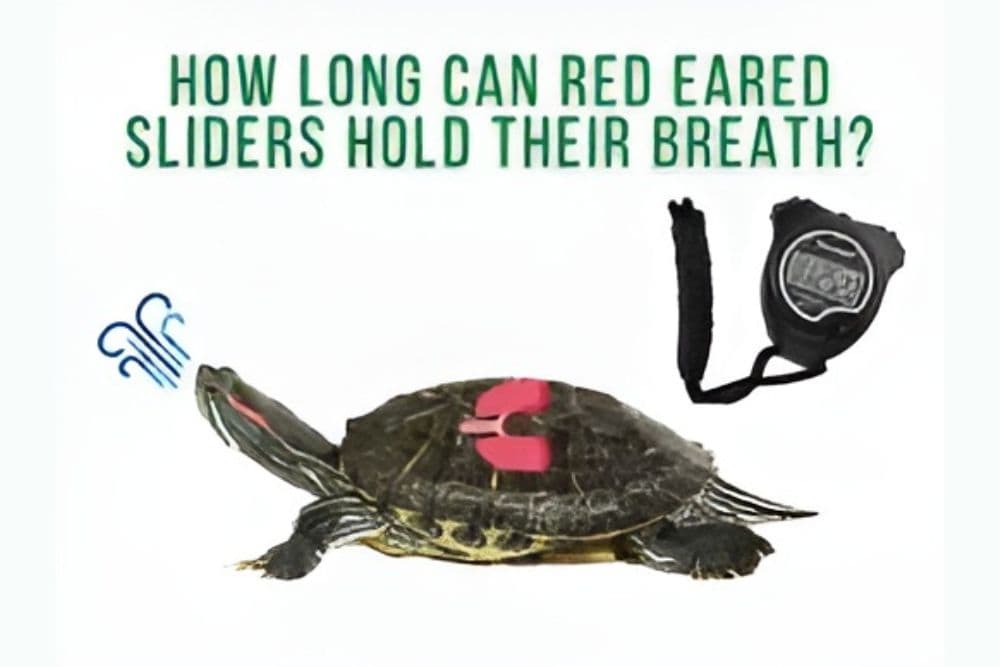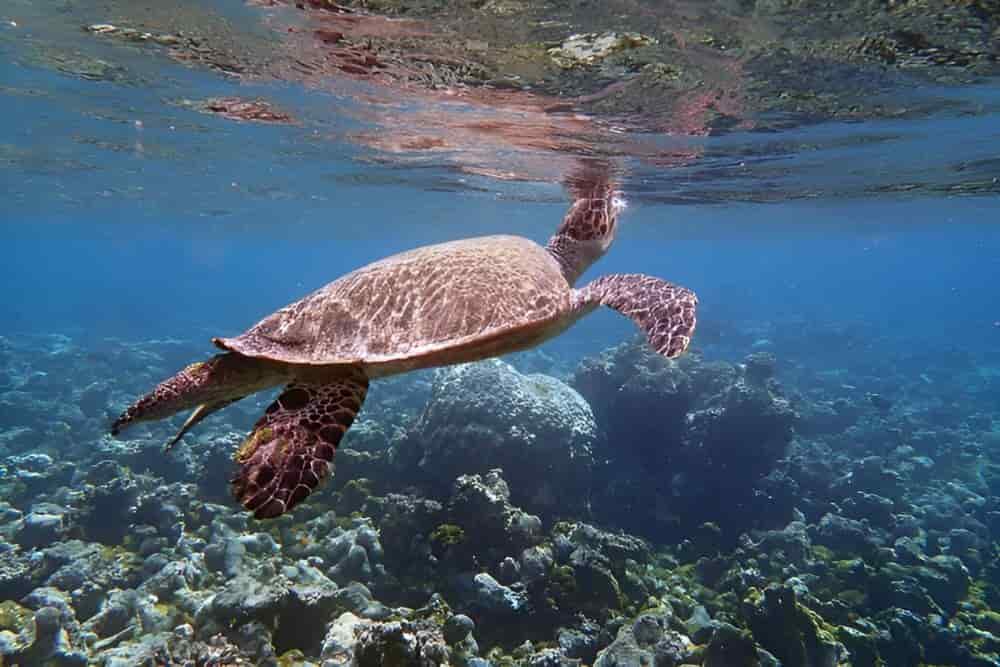How long can turtles hold their breath? Seeing a turtle gliding gracefully underwater, submerged for minutes or even hours, raises a common question among observers: “How long can turtles hold their breath? This question is very complex. Turtles are air-breathing reptiles with lungs, not gills, which means they need to surface periodically to breathe. However, various turtle species have evolved specialized adaptations that allow them to stay underwater for surprisingly long periods. Some species, such as sea turtles, can hold their breath for hours, while others, like freshwater turtles, employ unique breathing techniques to remain underwater throughout winter.
How long can turtles hold their breath? This guide delves into the physiology and adaptations that enable turtles to hold their breath, examining different species’ abilities and the environmental factors that affect their respiratory endurance. We gain a more detailed understanding of the survival strategies of these ancient reptiles.
How long can turtles hold their breath? Overview of Turtle Respiratory Physiology
How long can turtles hold their breath? To understand how long turtles can hold their breath, we must first explore their respiratory system and how it differs from other aquatic animals like fish. Here are the critical aspects of turtle respiration:
- Lungs for Air Breathing: Unlike fish, which use gills to extract oxygen directly from water, turtles rely on lungs to breathe. This means that all turtles, regardless of species, must periodically surface to take a breath.
- Unique Lung Adaptations: Turtles have highly efficient lungs that allow them to take in large amounts of oxygen with each breath. This efficiency supports long dives and, in some cases, even prolonged underwater hibernation.
- Ectothermic Metabolism: Turtles are cold-blooded reptiles with a lower metabolic rate than warm-blooded animals. This allows them to conserve energy and require less oxygen, enabling them to remain submerged for longer periods. How long can turtles hold their breath? These fundamental traits allow turtles to stay underwater for varying lengths, with specific adaptations helping different species achieve impressive underwater endurance.
How long can turtles hold their breath?
The ability of a turtle to hold its breath depends mainly on its habitat and lifestyle. How long can turtles hold their breath? Here’s a look at the breath-holding capabilities of different turtle types:

- Sea Turtles
Sea turtles are highly adapted for life in the ocean, where they must navigate long distances and dive to great depths. How long can turtles hold their breath? They have some of the most remarkable breath-holding abilities among turtles:
- Active Diving: During active swimming or foraging, sea turtles generally surface every 5 to 30 minutes for a breath.
- Resting: When sea turtles sleep, they can hold their breath for long periods. They achieve this by slowing down their heart rate and reducing oxygen consumption.
- Deep Diving: Some sea turtle species, such as the leatherback, can dive to depths of over 1,000 meters (3,280 feet) and hold their breath for over an hour. Their lungs are specially adapted to withstand high-pressure environments, allowing them to dive deep and remain submerged longer.
- Freshwater Turtles
Freshwater turtles, such as the painted turtle and red-eared slider, inhabit rivers, ponds, and lakes. While they are not as specialized for long dives as sea turtles, freshwater turtles have unique adaptations that allow them to stay submerged:
- Active Swimming: When active, freshwater turtles typically surface every 15 to 30 minutes, though they can hold their breath for longer if necessary.
- Winter Brumation: In cold environments, freshwater turtles enter a state called brumation (hibernation) during winter. During brumation, they can stay underwater for several months without coming up for air. They accomplish this by drastically slowing their metabolism and using cloacal respiration, where they absorb small amounts of oxygen through specialized tissues in their cloaca.
- Moderate Breath-Holding: Under normal circumstances, freshwater turtles can hold their breath for 30 minutes to an hour, depending on factors like water temperature and activity level.
- Semi-Aquatic Turtles
Their breath-holding capacity is more complex and moderate compared to fully aquatic species.
- Short Dives: Semi-aquatic turtles typically hold their breath for 15 to 30 minutes when swimming or foraging. Since they spend time on land, they don’t need to remain submerged for extended periods.
- Cloacal Respiration (Limited): Some semi-aquatic turtles can absorb limited oxygen through their cloaca, though they primarily rely on surfacing for air.
- Land Turtles (Tortoises)
Land turtles, or tortoises, are not adapted to aquatic environments and cannot hold their breath for extended periods underwater. How long can turtles hold their breath? However, they are capable of holding their breath for a few minutes if submerged:
- Brief Submersion: Tortoises can hold their breath for only a few minutes. Prolonged exposure to water can be harmful or even fatal for tortoises, as they are not equipped with the adaptations needed for long periods underwater.
Unique Adaptations That Enable Extended Breath-Holding

How long can turtles hold their breath? Turtles have evolved several specialized adaptations that enable them to stay underwater for varying lengths. Here are some fundamental mechanisms that allow turtles to hold their breath for extended periods:
- Cloacal Respiration
Cloacal respiration, or “butt breathing,” is a process in which specific freshwater turtles absorb oxygen through tissues in their cloaca, an opening used for excretion and reproduction. How long can turtles hold their breath? This unique adaptation benefits turtles in cold climates, allowing them to stay underwater during winter brumation without surfacing.
During brumation, a turtle’s metabolism slows significantly, reducing its oxygen requirements. Cloacal respiration provides enough oxygen to keep the turtle alive without frequent surfacing.
- Reduced Metabolic Rate
Turtles are ectothermic creatures, which means their body temperature is controlled by their surroundings. When water temperatures drop or during rest periods, turtles can lower their metabolic rate, allowing them to survive on less oxygen. Sea turtles, in particular, can slow their heart rate dramatically, sometimes beating only once every few minutes. This oxygen conservation keeps them submerged, especially while sleeping or resting.
- Efficient Lung Function
Turtles possess specialized lungs that enable efficient oxygen exchange. These lungs are large relative to their body size and can store significant amounts of oxygen. How long can turtles hold their breath? When turtles surface, they can quickly refill their oxygen stores, allowing them to remain submerged for extended periods. Sea turtles frequently dive to significant depths and have lungs that can collapse and reinflate easily, preventing complications from pressure changes.
How Environmental Factors Affect Breath-Holding Abilities
How long can turtles hold their breath? A turtle’s breath-holding capacity can be influenced by several external factors, including:
- Water Temperature
How long can turtles hold their breath? Turtles can hold their breath longer in colder water because their metabolic rate decreases. This is especially useful for freshwater turtles that hibernate in cold climates. By entering brumation in cold water, they can slow their body functions and survive on minimal oxygen.
- Activity Level
Active turtles need more oxygen, which means they must surface more frequently. When turtles are resting, they use less oxygen, allowing them to stay underwater longer. Sea turtles can hold their breath for hours when resting but may need to surface every few minutes during active swimming or foraging.
- Depth of Water
The depth of a dive influences how long sea turtles can stay submerged. Deeper dives require more oxygen, but efficient lung adaptations allow sea turtles to handle these dives with minimal energy expenditure, enabling longer breath-holding times.
The Importance of Breath-Holding for Turtle Survival
The ability to hold their breath underwater is crucial to turtles’ survival for several reasons:
- Predator Avoidance: Staying underwater allows turtles to hide from potential predators, especially in shallow water.
- Foraging and Feeding: Aquatic turtles need to dive for food, and their ability to stay submerged gives them access to rich underwater food sources.
- Thermoregulation: Turtles use breath-holding as part of their thermoregulation strategy. They can avoid overheating by staying submerged in cooler water, especially in warm climates.
Common Misconceptions About Turtles and Breath-Holding

- Turtles Can Breathe Underwater Like Fish: This is a misconception. Turtles cannot extract oxygen directly from water as fish do. They rely on lungs and, in some species, cloacal respiration to stay submerged.
- All Turtles Have the Same Breath-Holding Capacity: Different species have evolved unique adaptations for breath-holding, with sea turtles having the most extended capabilities.
- Turtles Never Surface During Brumation: While turtles in cold climates can stay underwater for months, they may occasionally surface if the water warms or oxygen levels drop.
Conclusion
How long can turtles hold their breath? Turtles possess remarkable adaptations that allow them to hold their breath underwater, enabling them to thrive in aquatic and semi-aquatic environments. From sea turtles that can hold their breath for hours to freshwater turtles that employ cloacal respiration during winter brumation, these adaptations showcase the diversity and resilience of turtle species. Holding their breath is essential to turtles’ survival, facilitating predator evasion, foraging, and temperature regulation.
Understanding turtles’ unique respiratory capabilities offers a glimpse into the incredible evolutionary journey these ancient reptiles have undertaken. How long can turtles hold their breath? By appreciating the complexity of their adaptations, we can foster a more profound respect for these remarkable creatures and work towards preserving their natural habitats. Whether basking on a log or diving deep in the ocean, turtles demonstrate an impressive balance of endurance and adaptability, embodying the resilience of life itself.
FAQ:
Q: What’s the longest a turtle can hold its breath?
Ans: Loggerhead turtles (Caretta caretta) voluntarily forage underwater for around 40 minutes in one go, but if held under water (and not in distress), a loggerhead can sustain itself on one breath for around 10 hours.
Q: How long can a turtle breathe underwater?
Ans: When they are active, sea turtles must swim to the ocean surface to breathe every few minutes. When they are resting, they can remain underwater for as long as 2 hours without breathing.
Q: How long can a whale hold its breath?
Ans: Whales can generally hold their breath for 45 minutes to up to two hours before needing to surface, depending on the species. Several factors contribute to this impressive feat. For one, whales can take in more air with each breath than humans can.
Q: How long can a penguin hold its breath?
Ans: A penguin can hold its breath for about 2 to 3 minutes while swimming. Some species, like the Emperor penguin, can dive even longer, up to 20 minutes.















Leave a Reply